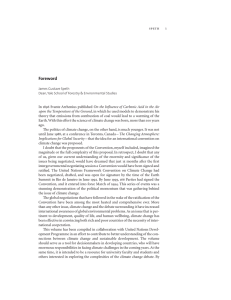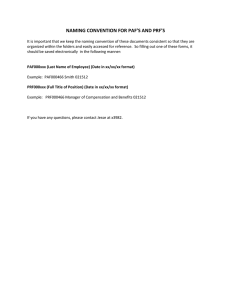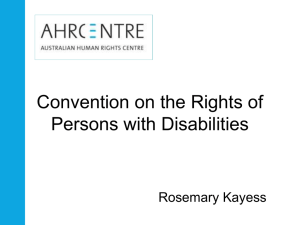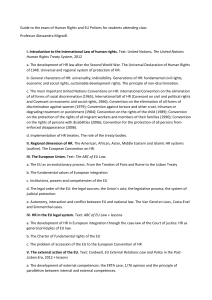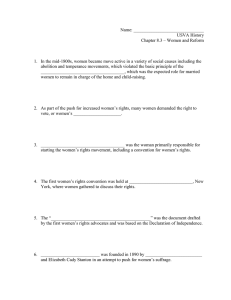OECD Workshop Regional Trade & Environment Tokyo, Japan June 19, 2007
advertisement
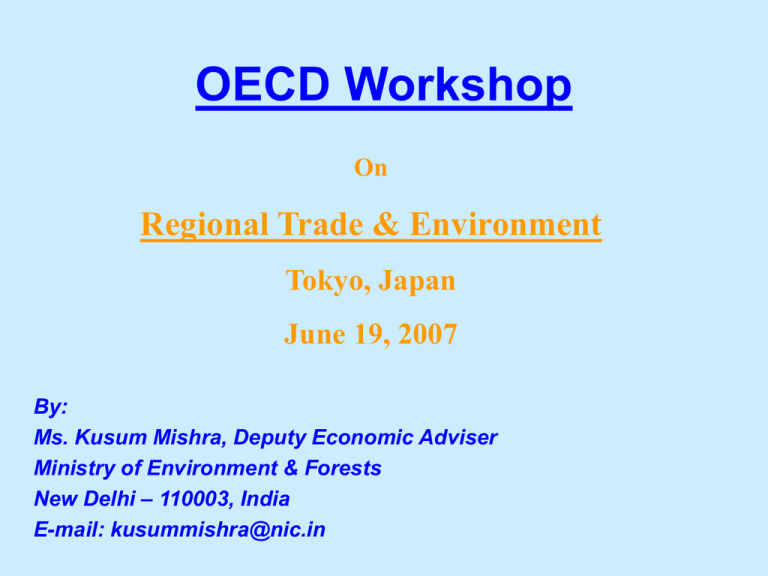
OECD Workshop On Regional Trade & Environment Tokyo, Japan June 19, 2007 By: Ms. Kusum Mishra, Deputy Economic Adviser Ministry of Environment & Forests New Delhi – 110003, India E-mail: kusummishra@nic.in Indian Economy : Fast Paced • Average GDP Growth of 8.5% in the past 3 Years. – Average Annual growth for Agriculture at 2.9% – Average growth for Industrial Sector at 9.8% – Services Sector average growth at 10.2% GDP Growth for 2007-08 is projected at 9% Trade : A Growth Engine • Major economic reforms introduced in the early 1990’s. • Since then foreign trade has grown steadily and emerged as a critical sector for achieving higher growth. • India’s trade volume jumped from US$ 42 billion in 1990-91 to US$ 221 billion in 20052006, translating into an average annual growth of 28.4%. – Export Volume in 2005-06 at US$90 billion – Import Volume in 2005-06 at US$131 billion Regional Trading Arrangements – Approach/1 • India views Regional Trading Arrangements (RTAs) as ‘building blocks" for trade liberalization and multilateral trading system. • India has come out from a guarded approach to regionalism for enhancing trade. • In principle Agreements/Free Trade Agreements with Major Trading Partners / Blocks in goods, services & investments. • Framework agreements with a number of trading partners with specific road maps within specified time frames. Regional Trading Arrangements – Approach/2 • Joint Study Groups set up for examining feasibility of CECA between India-Japan, IndiaIndonesia, India-Brazil-South Africa and IndiaRussia. • India and European Commission set up a High Level Trade Groups (HLTG) as mandated by the India-EU Summit held in New Delhi on September 7, 2005. • HLTG mandated to explore ways to enhance bilateral economic co-operation including a comprehensive trade & investment agreement. • The 7th India EU Summit held in Helsinki in October, 2006 accepted HLTG’s report. Current Engagements to RTAs/1 • Agreement on South Asia Free Trade Area (SAFTA) • Agreement on India-Bhutan Trade & Commerce • India-Sri Lanka Free Trade Agreement • Trade Agreement between India – Bangladesh & India & Maldives • India-Nepal Treaty of Trade • Indian–Afghanistan Preferential Trade Agreement • India-MERCOSUR PTA • Joint Study Group between India and Russia • Negotiation between India-Korea & India-Japan • RTA Negotiation between India-China • Framework agreement on CEC, India-ASEAN Current Engagements to RTAs/2 • India-Singapore Comprehensive Economic Cooperation Agreement • Framework Agreement for establishment Free Trade between India and Thailand • Joint Study Group for Comprehensive Economic Cooperation Agreement between and Malaysia • Joint Study Group for Comprehensive Economic Cooperation Agreement between India and Indonesia • Free Trade Agreement between Indian and Gulf Cooperation Council • Israel-India Joint Study Group and Implementation of its recommendations • PTA/CECP Agreement between India and Mauritius Current Engagements to RTAs/3 • PTA/CECP Agreement between India and Mauritius • Frame Work Agreement with South Africa Customs Union • Asia Pacific Trade Agreement • Bay of Bengal Initiative for Multi - Sectoral Technical and Economic Cooperation (BIMSTEC) • Global System of Preferences • Generalized System of Preferences • India-EU High Level Trade Group Environmental Initiatives • India views that trade and environment should be mutually supportive with the objective of Sustainable Development. • One of the strongest proponents of MEAs and is party to all the major MEAs. Commitment to Sustainable Development/1 • Beginning was made with the preparation for the Stockholm Conference on Human Development 1972. • Helped to prioritise environmental protection and conservation of natural resources within the country. • In the following two decades India developed organizational structure and effected major environmental legislation. • UN Conference on Environment & Development at Rio in 1992 infused the concept of sustainable development with country specific programs. • In 1992 India released the National Conservation Strategy and Policy Statement on the Abatement of Pollution. Commitment to Sustainable Development/2 • In 2002, India reaffirmed its commitment to sustainable development in the World Summit on Sustainable Development at Johannesburg. • Decade of 1990s has seen spurt of new environmental laws / amendments of older ones. • Govt. guidelines for production process certificates to ensure environmentally sound production and management practices for export goods. (WTO environment provisions-Agreement on Technical Barriers to Trade). • Being a signatory to the 1992 CBD, India recognises the significance of traditional knowledge in biodiversity held by indigenous local communities. • The WTO agreement on TRIPS encouraged compilation of data on other materials in machinereadable form to constitute intellectual creations for protection (TRIPs 10) International Agreements & Conventions • India participated in major international events on environment since 1972. • Signed and ratified a number of key multilateral agreements on environment issues in recognition of the trans-boundary nature of several environmental problems. • Efforts made to network and enhance environmental cooperation by participating in regional and bilateral programs. • Bilateral MOUs / Agreements with 12 countries. • JWGs on environment set up with EU, Finland, UK: and being set up with Norway • MOU with US EPA renewed • MoEF makes annual contributions to UNEP, ICIMOD, SACEP, UNFCCC, CBD, UNCCD, Basel Convention, Rotterdam Convention, Montreal Protocol, Vienna Convention etc. • Need to enhance our own capacity to comply with commitments. • Ministry’s delegates participate in important international meetings on environment & provide valuable inputs. Recommendations of the Steering Committee for 11th Plan (2007-12)/1 • Initiatives to integrate the global environmental agreements with efforts at the national level. • Need to assess the priorities of different international conventions and our strategies for the future. 1. Basel Convention An action plan for efficient, cost effective recycling and disposal strategy for electrical and electronic waste be drawn up. Recommendations of the Expert Committee Report on ship-breaking to be implemented. Basel ban and Basel Protocol be studied for ratification. Amendments to exclude recyclables from the Hazardous Waste (Management and Handling) Rules, 1989, amended 2000, 2003. Recommendations of the Steering Committee for 11th Plan (2007-12)/2 2.The Rotterdam Convention (PIC) Legislation / amendments to existing legislations to implement the provisions/obligation of the convention be notified. A study to document status of 41 chemicals now covered, be conducted. A National Action Plan for implementation to be drawn up. 3. The Stockholm Convention (POPs) National Implementation Plan to be completed by 2008. Investment projects to be drawn up in parallel. Status of new POPs, POPs covered under OSPAR & LRTAP in the country to be prepared. 4. SAICM A work plan prioritizing the activities in the Global Plan of Action (GPA) for country be drawn up. An Inter-ministerial Coordination Committee to be established to ensure timely action and implementation. Recommendations of the Steering Committee for 11th Plan (2007-12)/3 5. Bio-safety Ensure the conservation of biodiversity and human health when dealing with Living Modified Organisms (LMO’s) in trans-boundary movement in a manner consistent with the Bio Safety Protocol. Review the regulatory processes for LMOs so that all relevant scientific knowledge and international regimes are taken into account, and ecological, health & economic concerns are adequately addressed. Periodically review the National Bio-safety Guidelines and Bio-safety Operations Manual to ensure that these are based on current scientific and international understanding. Role of Ministry of Environment and Forests/1 • The Ministry is the nodal agency in the Government for various environment related multilateral conventions and protocols. These are: Convention on International Trade in Endangered Species, Convention on Wetlands Of Internal Importance Convention on the Conservation of Migratory Species of Wild Animal Vienna Convention on the Protection of Ozone Layer Montreal Protocol on Substances that deplete the Ozone Layer Conventions on Biological Diversity UN Framework Convention on Climate Change Role of Ministry of Environment and Forests/2 Kyoto Protocol Basel Convention on Trans-boundary Movement of Hazardous Substances Convention to Combat Desertification Stockholm Convention on Persistent Organic Pollutants. India has been pursuing its commitments under various conventions vigorously by initiating various measures nationally and by taking several important initiatives in the region. Issues to be Addressed • Need to identify synergies and overlaps between the various MEAs. • Need to explore synergies between MEAs and RTAs. • More resources required for ensuring sustainable development. • Environmental measures should be compatible with open, equitable and non-discriminatory nature of the multi-lateral trading system. • Technical and financial assistance for compliance. • Additional market access to mitigate negative effect of environmental measures. • Recognise sovereign rights for biodiversity. Thank You!
